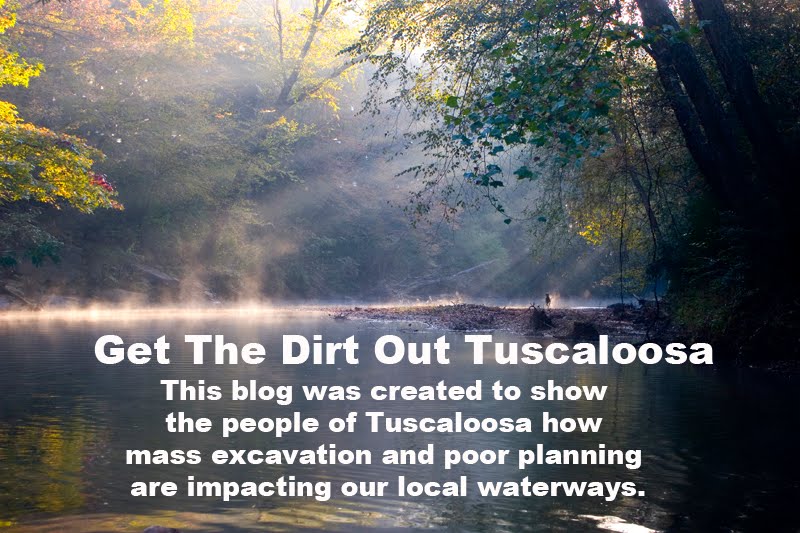Joe Robinson made the statement below. He is referring to the rain on the 26th. What about the other 3 flooding events that were NOT excessive rain?
“We cannot design for the really heavy rain events,” Robinson said, “just like we can't design McFarland Boulevard to handle (University of Alabama football) game-day traffic.
“Sometimes, you're just going to have that flooding regardless.”
City identifies 16 new flood-prone areas
Dusty Compton | Tuscaloosa News
Anne McNeff sits among stacked furniture and bare concrete floors in the home of Betty Jones on Sierra Gardens Dr. in Tuscaloosa, Ala. Tuesday, Aug. 3, 2010. All of Jones carpet and flooring had to be removed due to the water and her home is not covered by flood insurance and was originally deemed a "safe-zone" and not in a flood plane. Jones, along with several of her neighbors in the Ashbrook subdivision, have had their homes flooded by recent rain and all since the construction of The Woodlands apartment complex. McNeff also had her garage flooded.
Published: Wednesday, August 4, 2010 at 3:30 a.m.
Last Modified: Tuesday, August 3, 2010 at 11:30 p.m.
Last Modified: Tuesday, August 3, 2010 at 11:30 p.m.
In 2006, the city of Tuscaloosa embarked on an ambitious, multimillion-dollar program to overhaul the city's stormwater drainage system.
Related Links:
Called “Noah's Ark,” the program focused on 13 sites across the city where flooding had become a problem. City leaders said at the time that the plan was to correct problems in these areas to curb flooding throughout the rest of the city.
The city has committed $22 million to the program and expanded it to include projects in six other flood-prone areas. Thirteen of the 19 projects have been completed or nearly completed, according to the Office of the City Engineer.
But they may be only the beginning.
A rainstorm on July 26 dumped massive amounts of water across the region, so much that between 15 and 20 more sites across the city have seen floodwaters cover streets and damage homes. In some places, the water reached a depth of 4 feet.
“We've had flooding where we've not seen flooding before,” said Mayor Walt Maddox.
In the days after the rain, Maddox initiated the city's incident response plan and appointed Robin Edgeworth, the legal affairs administrator for the Office of the City Attorney, and Assistant Chief John Brook of the Tuscaloosa Fire and Rescue Service as commanders.
Their role was to coordinate the gathering of information about the various flood-hit areas and maintain an organized log of responses.
On Tuesday, Edgeworth updated the City Council's Projects Committee on the response effort's current progress. She said that among these findings, the city engineer's office had identified at least 16 new flood-prone areas “that require continued assessment, evaluation and possible improvements.”
Maddox also has hinted that correcting the new problem spots could require a similar, Noah's Ark-style approach, in particular at the homes and areas across Hargrove Road from The Woodlands of Tuscaloosa, a large, new apartment complex that some believe is causing the new flood problems in that part of the city.
“We're taking a systematic approach to this issue,” the mayor said. “The flooding from (July 26) demonstrated a lot of issues in our drainage system that we need to evaluate.”
If additional large drainage projects are needed, city leaders are likely to use the success of the Noah's Ark program as a reason they need to continue such projects.
The 13 Noah's Ark drainage improvement projects completed so far have eliminated flooding problems for “tens of thousands” of residents, according to the city engineer's office.
“I think one of the most telling things is, we didn't really have many flooding problems at all in the Noah's Ark areas with the latest rainfall events,” said City Engineer Joe Robinson. “The flooding has been in areas other than the Noah's Ark areas.”
Of the areas that saw heavy flooding during the July 26 storm, most, if not all, were outside the Noah's Ark project zones.
But the idea of investing millions of additional dollars to correct new drainage problems is not welcome to all.
John Wathen, a local environmentalist who has long criticized the city's approach to stormwater control, blamed the need for Noah's Ark on the city's previous bad decisions.
“With Noah's Ark, we are spending millions to fix flood problems that (are) the result of bad planning,” Wathen said. “In my opinion, it has in no way fixed the problem. With Noah's Ark, we've sent accelerated runoff further downstream ... (and) pushed the flooding problems outside the city's jurisdictions, where the people have no voice.”
Wathen, who heads Friends of Hurricane Creek and is creekkeeper for the environmentally sensitive waterway, said the Hargrove Road problems are directly attributable to the construction of The Woodlands.
He also blames city officials for approving the runoff and stormwater control plans designed by the developers.
“It's time to change politics,” Wathen said. “Or it's time to change politicians who are rubber-stamping these projects that are detrimental to our communities.”
While Maddox and others have expressed concern about the effect The Woodlands has had on the Hargrove Road drainage basin — concerns that have kept the city from issuing a certificate of occupancy for the 350-unit complex — they take issue with the claim that poor city oversight allowed the problem.
For now, Robinson is blaming the rain. He said the city's most modern stormwater drainage systems are designed to handle a 25-year level flood. The July 26 storm fell between the National Oceanic and Atmospheric Administration's standards for a 50- to 100-year flood.
“We cannot design for the really heavy rain events,” Robinson said, “just like we can't design McFarland Boulevard to handle (University of Alabama football) game-day traffic.
“Sometimes, you're just going to have that flooding regardless.”

No comments:
Post a Comment
Feel free to leave a comment. No profanity! No personal attacks please.